

 Copyright 2010 Foundation for Critical Thinking
Copyright 2010 Foundation for Critical Thinking
Foundation for Critical Thinking Press
707-878-9100
www.criticalthinking.org
All rights reserved. No part of this guide may be reproduced, in any form or by any means, without permission in writing from the Foundation for Critical Thinking, except for the quotation of brief passages in criticism.
Printed in the United States of America.
ISBN 978-0-944583-42-5
The Thinkers Guide to Clinical Reasoning
Contents
Guide
The elements of clinical reasoning that appear in the diagram below provide the basis for analyzing the structures present in all thinking. Whenever we think, we think for a purpose within a point of view based on assumptions leading to implications and consequences. We use concepts, ideas, and theories to interpret data, facts, and experiences in order to answer questions, solve problems, and resolve issues.
Each of these structures has implications for the others. If you change your purpose, for example, you change your questions and problems. You are then forced to seek new information and data. And this changes the implications and consequences of your conclusions and decisions.

Used With Sensitivity to Universal Intellectual Standards

1)All clinical reasoning has a PURPOSE.
- Can you state your purpose clearly?
- What is the objective of your clinical reasoning?
- Does your reasoning focus throughout on your clinical goal?
- Is your clinical goal realistic?
2)All clinical reasoning is an attempt to figure something out, to settle some QUESTION, to solve some PROBLEM.
- What clinical question are you trying to answer?
- Are there other ways to think about the question?
- Can you divide the question into sub-questions?
- Is this a question that has one right answer or can there be more than one reasonable answer?
- Does this question require clinical judgment rather than facts alone?
3)All clinical reasoning is based on ASSUMPTIONS.
- What assumptions are you making? Are they justified?
- How are your assumptions shaping your point of view?
- Which of your assumptions might reasonably be questioned?
4)All clinical reasoning is done from some POINT OF VIEW.
- What is your point of view? What insights is it based on? What are its weaknesses?
- What other points of view should be considered in reasoning through this problem? What are the strengths and weaknesses of these viewpoints? Are you fairmindedly considering the insights behind these viewpoints?
5)All clinical reasoning is based on DATA, INFORMATION, and EVIDENCE.
- To what extent is your reasoning supported by relevant data?
- Do the data suggest explanations that differ from those you have given?
- How clear, accurate, and relevant are the data to the clinical question at issue?
- Have you gathered data sufficient to reach a valid conclusion?
6)All clinical reasoning is expressed through, and shaped by, CONCEPTS and THEORIES.
- What key concepts and theories are guiding your clinical reasoning?
- What alternative explanations might be possible, given these concepts and theories?
- Are you clear and precise in using clinical concepts and theories in your reasoning?
- Are you distorting ideas to fit your agenda?
7)All clinical reasoning contains INFERENCES or INTERPRETATIONS by which we draw CONCLUSIONS and give meaning to data.
- To what extent do the data support your clinical conclusions?
- Are your inferences consistent with each other?
- Are there other reasonable inferences that should be considered?
8)All clinical reasoning leads somewhere, that is, has IMPLICATIONS and CONSEQUENCES.
- What implications and consequences follow from your reasoning?
- If we accept your line of reasoning, what implications or consequences are likely?
- What other implications or consequences are possible or probable?

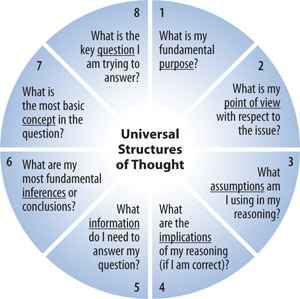
Note: When we understand the structures of thought, we ask important questions implied by these structures.
A 53 year old man complains of severe pain in his left big toe for the past 2 days. The patient has a past medical history of two episodes of acute gouty arthritis in the past 3 months, hypertension for 10 years, and dyslipidemia. He is currently receiving a thiazide diuretic for his high blood pressure, atrovastatin for his high cholesterol, and one aspirin tablet daily to prevent heart attacks. Laboratory studies revealed a serum urate concentration of 10mg/dL and a very high urinary urate concentration. The patients blood pressure is 130/80 mmHg. A positive diagnosis of acute gouty arthritis was confirmed by taking a sample of the patients synovial fluid taken from the affected joint and examining it under a polarizing microscope.
Purpose:
To treat the acute attack and to prevent recurrent attacks.
Questions
- 1.What is the most effective way to treat this patients acute attack?
- 2.What is the most effective way to prevent recurrent attacks in this patient?
- 3.What adjustments, if any, need to be made to this patients other medications?
Assumptions
- 1.Colchicine will not work in this case.
- 2.Baby aspirin will not significantly increase serum urate concentrations.
- 3.Traditional medicine has the best answers in a case like this, so we dont need to consider alternative therapies.
Points of View
- 1.A conservative approach would be to treat the acute attack and discontinue the thiazide diuretic because it increases serum uric acid concentration and therefore the propensity for recurrent attacks.
- 2.A more aggressive approach would be to initiate preventive therapy irrespective of the decision to continue or discontinue the diuretic.
Information
- 1.Either colchicine or a non-steroidal anti-inflammatory agent can be used to treat acute attacks.
- 2.Colchicines effectiveness diminishes 48 hours after onset of pain.
- 3.Either probenecid or allopurinol can be used to prevent recurrent attacks.
- 4.Probencid increases urinary uric acid excretion.
Next page

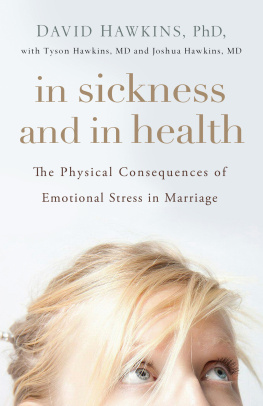

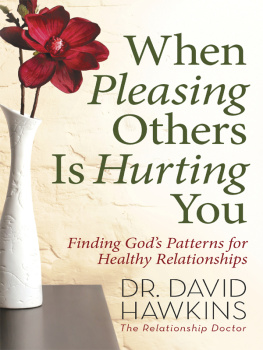
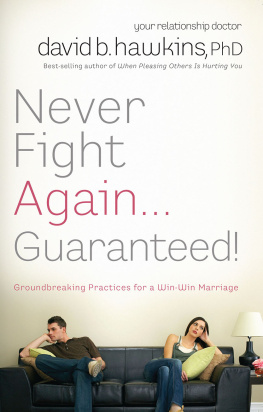
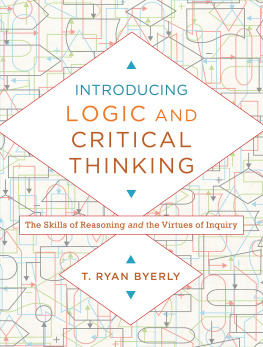
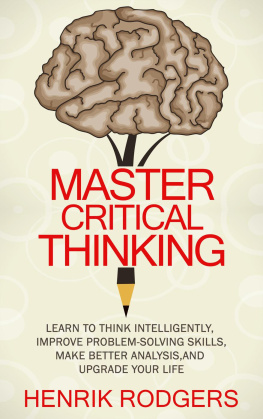
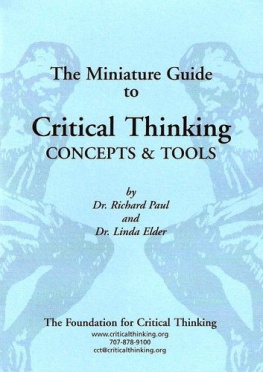
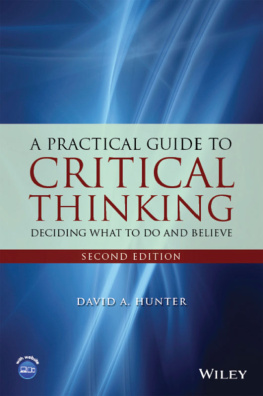



 Copyright 2010 Foundation for Critical Thinking
Copyright 2010 Foundation for Critical Thinking


